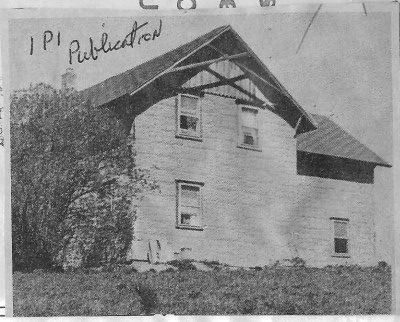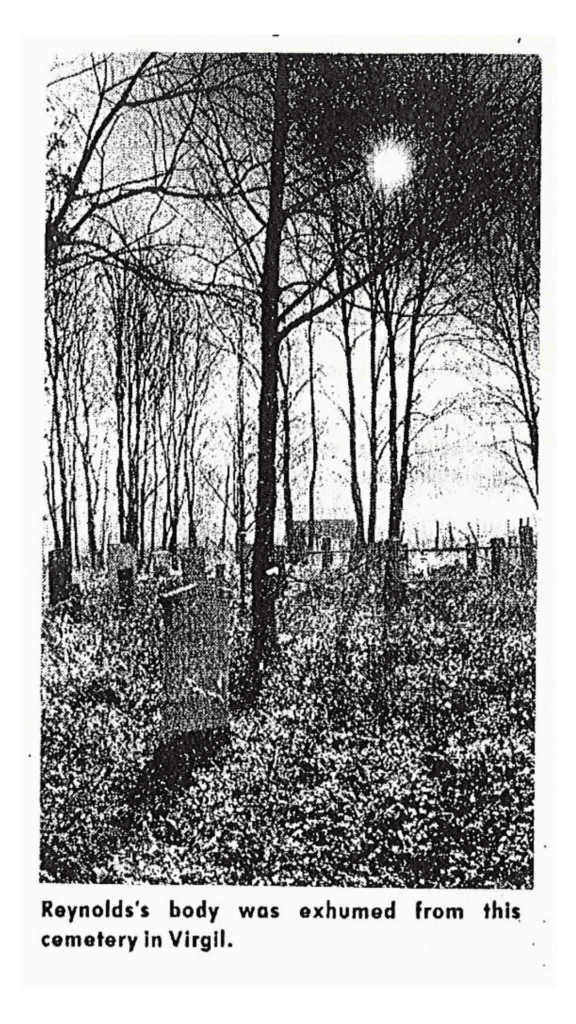Egar Allen Poe famously said, “The boundaries which divide Life from Death are at best shadowy and vague.”
Here unfolds the petrifying tale of a place where that shadowy veil was so thin a poltergeist seething with rancor slipped through the divide. You may want to roll up your windows for this road trip, folks, lest you bring an uninvited guest home.
Location #1: : The Haunted House at Holler Rd & NY-392,
Virgil, NY
(42.51110775576303, -76.18120191687038)
In 1866 the Dryden Weekly News published one of the most haunting stories in all of Cortland County’s history.
The story unfolds during an unseasonably cool spring in 1866, when a young Irish family, the Downey’s, bought the farm that once stood here. Robert, Florence and their young children were of little means but well respected by the community. However, it wasn’t very long before this loving family experienced the fright of a lifetime.
It began subtlety enough; doors, once shut, were discovered ajar. The sounds of rattling stove lids and tables and chairs scraping across the empty kitchen floor reverberated throughout the house. The strange occurrences continued steadily escalating until one night, only after Florette tucked the children snuggly in bed, it rose to an undeniable crescendo. The house began to vibrate with knocking and noises so loud they could be heard from more than a quarter mile away.
Word of the hauntings spread like wildfire and soon crowds gathered nightly in great numbers to witness this paranormal event.
On August 8, 1985, in a retelling of events, the Syracuse Herald American Journal wrote, “From the records of the time, the strangest part of all these unexplained happenings was that they never occurred until Mrs. Downey and her children had retired for the night. Thus, it was generally believed that she caused the phenomenon, witnessed by innumerable persons, through some contrivance she had rigged up. So curious as to the cause of these weird happenings were the crowds who gathered night that ‘they nearly tore the house apart looking for the control, which they believed responsible, but nothing was ever found.’”
For months, the poltergeist continued to terrorize the home, much to the macabre delight of the regular onlookers. Gawkers traveled from miles around to witness the paranormal display, some even bringing firewood and lamp oil to the poor, distraught Downey family. However, not everyone who came to the Downey farm was a true believer.
The Cortland Democrat, on March 19, 1954, in a republishing of events, wrote, “When a sincere crowd would gather there was plenty of action, but when a rough crowd came all was still.”
Sensing that the spirit might be friendly, guests grew brave and began interacting with it, holding séances in the home. The line of questioning was met with a standard response: one knock for yes and two knocks for no.
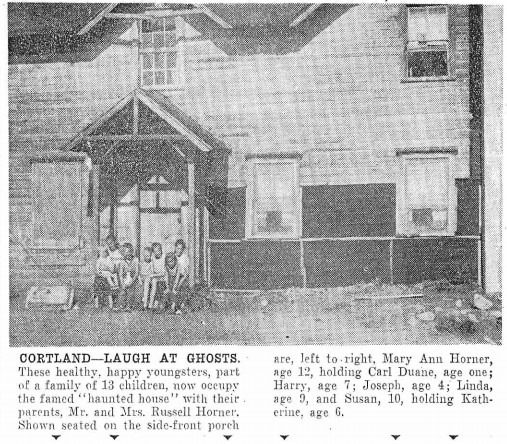
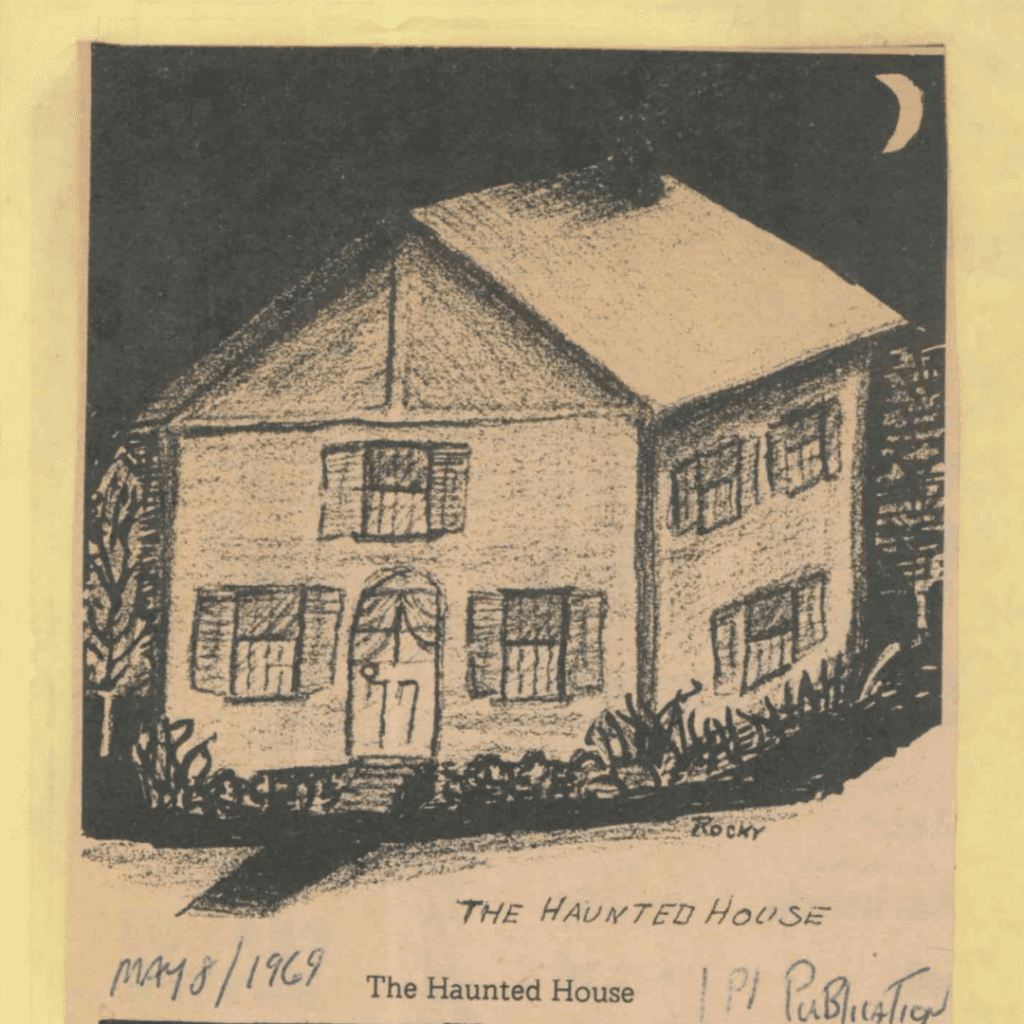
One evening, in particular, the Downey’s neighbor, Richard Tyler, brought D. M. Ables, who was quite deaf, to the house. The Syracuse Herald American Journal reported, “The crowd requested that the ‘spirit’ give louder tapings, so that Mr. Ables might hear them. So loud did they become that not only was he able to hear them, but also when he was leaving and was some distance down the road.”
It was soon deduced through a series of knocks that the benevolent spirit was that of Elijah Reynolds, whose son had resided in the house along with his daughter-in-law Sarah (Sally) Ann Hutchings. Virgil maps from 1855 show that Eli had lived with his wife, Mary Ryan, across the road and a few fields down. At some point, the families came to live under one roof until Eli’s sudden death in 1859. Records show “cholera morbus” as his cause of death, the term used in the 1800s for severe vomiting and diarrhea.
According to the Dryden Weekly News published June 21, 1866, “The invisible agency producing the remarkable phenomena of lights, rappings, drummings and other manifestations purporting to be no other than the intelligence or spirit of a Mr. Reynolds who died very suddenly after only a few hours illness nearly seven years ago. The burden of intelligence arrived at through significant sound or rappings was that he, Mr. R., had come to his death by administration of poison!”
According to historical records, the original house inhabited by the Reynolds and the Downeys disappeared off the map by 1876, sometime after the Downeys left the area. Historians suspect the original structure may have burned. Another house was eventually built in its place, and according to local papers, the hauntings continued through the 1980s when eventually the house was demolished. Now, only a cornfield remains where the haunted house of lore once stood.
Location #2: The Place of Unrest: Seager Cemetery at 1578 NY-392,
Virgil, NY
(42.509904539108675, -76.17007171022048)
To access the Seager Cemetery, park along the shoulder of the road and follow the mowed path at the edge of the property, alongside the creek. Cross over to the cemetery where the black cherry trees begin. The cemetery is clearly defined by old fencing and a ring of trees. The surrounding land is all private property. Do not trespass and please keep a respectful volume. Visiting hours are from dawn till dusk.
Prior to the Downey’s, the Reynolds family resided on the farm. Though Eli, his son Orson and his daughter-in-law Sarah (Sally) Ann Hutchings did not make for a happy family. Neighbors at the time reported that Eli and his daughter-in-law, Sally Ann, were far from friendly. Often, their arguments escalated in volume until they were heard by those passing by. According to the Cortland Democrat (March 19, 1954) “The father and the daughter-in-law were none too congenial. The father died very suddenly and was buried in a little cemetery east of Virgil on the old Samuel Sager place. Shortly, Orson and his young wife moved away to Allegany County, it was said.”
The old Samuel Seager place would eventually become the Seager Cemetery, where you are standing now. Though poor Eli Reynold’s tombstone seems to have been lost to time. His story, thanks to his enterprising spirit, has not.
During one of the nightly séances held by the Downey’s and their guests, a gruesome tale of murder began to unfold. One brave guest asked how it was that Mr. Reynold met his fate. In a nearby cabinet, a spoon rattled in a cup. Could poison have been administrated from this cup, they inquired? One clear knock resonated through the home. Devising a system, they called out the individual letters of the alphabet, seeking to discover the ingested toxin. Slowly, methodically, the spirit spelled out arsenate of lead.
The excitement at the discovery led to an outcry. Citizens voiced their suspicion of the Reynolds’s sudden departure following Elijah’s hasty burial. In an effort to quell suspicions, authorities scheduled an exhumation and autopsy to be conducted by Virgil’s coroner, Dr. Trip, despite the Reynolds family’s objections.
“This decision was communicated to the spirit, when as if to manifest its approval, gave some of the most powerful manifestation that has been given. Between the hours of eleven and one, the house was in extreme agitation, causing the windows to rattle, the furniture about the room to tremble in an astonishing manner, even the lamp upon the table shook so perceptibly that the kerosene swayed to and fro within the lamp. The rappings were so loud that it was thought by those present that it could be heard at least a half-a-mile from the house, indeed a family living in a quarter of a mile distant were aroused from the slumber and got up to listen to the noise.” (Dryden Weekly News 21 June, 1866)
The evening before the exhumation, so confident was the spirit of Elijah Reynolds that he gave his most exuberant and flamboyant performance yet.
“About half past nine faint sounds were heard, growing more and more loud and distinct every moment, seemingly upon walls, on the sides and above the room, and changing its position at will, and varying the tone, number and manner of rappings to suit the caprice of the listener, till at last it became so loud as to be heard with great distinctness in every room in the house and some distance from the house—responding by loud raps to questions—amusing the audience by imitating distant thunder, and more especially impersonating a drummer, the raps vibrating like beating upon a bass drum and playing accompaniment to various hymns sung by person present, and when let alone would play out of its own accord other tunes, mostly martial music, among them “Yankee Doodle,” the “Death March” and others with surprising beauty and exactness.” (Dryden Weekly News 21 June, 1866)
The following day, the exhumation of Eli Reynolds, dead and buried seven years prior, unfolded before a large crowd. “With several physicians in attendance [they] exhumed the body and formally dissected it. The respiratory organs, lungs, heart and also most of the liver, intestines, all the internal organs were decayed, leaving no form except the stomach and a small portion of the liver which lay in close proximity to the stomach. On removing the stomach from the body, it was found in a perfect state, so nearly so that the mucus membrane could clearly be seen.” (Dryden Weekly News June 21, 1866)
The stomach was then sent to Albany for analysis by a trained chemist, where it was discovered that it had been preserved by its contents- enough arsenic lead to kill half a dozen grown men! Poor Mr. Eli Reynolds had indeed been murdered.
Records show that Eli’s wife, Mary Ryan Reynolds, moved with her son Orson and daughter-in-law Sally Ann to Allegany County, where she remained with them in her old age. No further records have been discovered showing charges pressed for the murder of Elijah Reynolds. One can only assume there simply wasn’t enough evidence.
Eli Reynolds’ wife, son, daughter-in-law, and descendants are buried in Black Creek Cemetery in Allegany. All except poor Eli Reynolds. Despite records showing Eli having lived from 1792-1859 and recording his cause of death in Virgil NY, Elijah is not listed in this cemetery, or in any cemetery in Cortland County or anywhere else in the US. It is as if, through the passing of time, some guilty ghost has worked to remove any further evidence from discovery.
Legend says that Eli’s soul will not rest until his final resting place is marked once more. Are you brave enough to listen for the knocks?
On the southern boundary of the Segar Cemetery, you will find two delicate headstones. These haunting vestiges belong to sisters Lucy and Harriet N. Reynolds. Daughters of Eli and Mary Ryan, their stones each bear a portion of an excerpt from the book The Velvet Cushion by John William Cunningham.
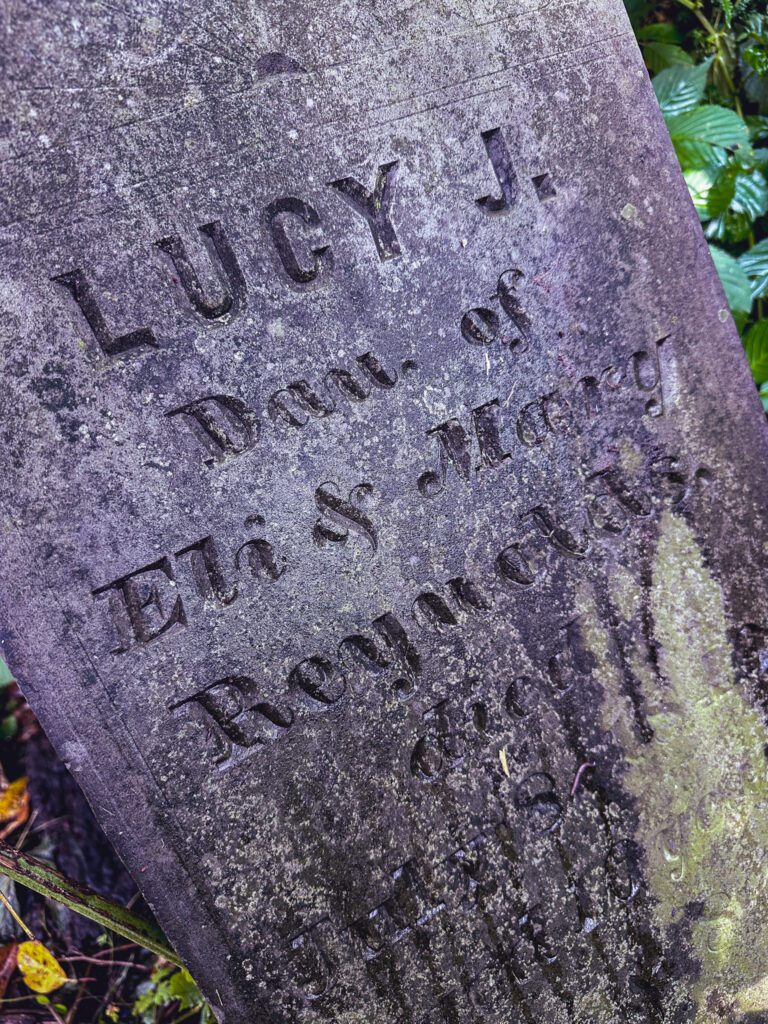

Lucy (July 6, 1830- July 8, 1840):
It died to sin, it died to care
But for a moment felt the rod
Then, spreading on the viewless air
Spread its light wings, and soared to God.
Harriet (December 4, 1841-February 2, 1843):
As sweet the flower that scents the morn,
But withers in the rising day;
Thus lovely was this infant’s dawn,
Thus swiftly fled its life away.
Sources
1. 1855 Map of Virgil (Virgil Historical Society)
2. 1876 Map of Virgil (Virgil Historical Society)
3. The Rappings Ceased (1866, June 21) Dryden Weekly New
4. Rock’s Rambles (1969, May 8) Untitled Newspaper CCHS Archives
5. Children’s Laughter Sill Noises in ‘Haunted House’ Near Virgil (1985, August 7) Syracuse Herald American Journal
6. The Legend of the Haunted House (1954, March 19) The Cortland Democrat
7. ‘Charlie” Was No Stranger Here (1979, October 31) Paul Ladolce and Bob Dann Untitled Newspaper CCHS Archives
8. Cunningham, J. W. (1814). The Velvet Cushion. London : Printed for T. Cadell and W. Davies by G. Sidney.
